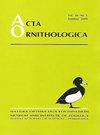Effect of Habitat Structure and Crop Diversity on Common and Threatened Birds Breeding in Semi-Natural Field Margins
IF 1.3
4区 生物学
Q3 ORNITHOLOGY
引用次数: 5
Abstract
Abstract. Field margins are inherent elements of European agricultural landscapes, thought to be crucial for maintaining a high biodiversity level. The interactions between the structure of field margins and biota have been recognized, yet the understanding of the importance of various components of the margins and adjacent areas is still incomplete. The aim of our study was therefore to determine the relative importance of structural features of the margins and diversity of adjacent crops for birds breeding in field margins. The study was carried out in 70 field margins covered with semi-natural vegetation, situated in SW Poland. Both the number of species and bird density were most strongly positively related to the development of tree and shrub layers, while presence of ditches and percentage of reed cover (positive effects) had much less importance. Analyses conducted at the species level revealed the complexity of bird-habitat interactions resulting from various requirements of individual species. Overall, for 22 abundant species and for the threatened species, the development of the shrub layer turned out to be a particularly important feature of field margins positively associated with occurrence of e.g. Emberiza citrinella, Linaria cannabina and Streptopelia turtur. Other significant positive effects had the development of the tree layer (e.g. Turdus merula and Turdus philomelos), presence of ditch (e.g. Acrocephalus palustris, Sylvia communis), and number of gaps in woody vegetation (e.g. Lanius collurio). The diversity of adjacent crops had positive effects only to some threatened species (e.g. L. collurio and E. calandra). Abundances of common and threatened birds were not correlated, which reflects different habitat demands of these two groups. Because of diverse bird-habitat relationships, maintaining a variety of field margins (in particular the shrubby ones), should be accepted as a rule in biodiversity-oriented management of agricultural landscapes.生境结构和作物多样性对半自然田缘常见鸟类和濒危鸟类繁殖的影响
摘要田地边缘是欧洲农业景观的固有元素,被认为对维持高生物多样性水平至关重要。田缘结构与生物群之间的相互作用已被认识到,但对田缘和邻近地区各组成部分的重要性的认识仍不完整。因此,我们研究的目的是确定边缘结构特征和邻近作物多样性对鸟类在田间边缘繁殖的相对重要性。这项研究是在波兰西南部70个覆盖着半自然植被的田野边缘进行的。物种数量和鸟类密度对乔灌木层发育的正向影响最为显著,而沟渠的存在和芦苇盖度(正向影响)的重要性较低。在物种水平上进行的分析揭示了鸟类与栖息地相互作用的复杂性,这是由于个体物种的不同需求造成的。总体而言,对于22种丰富的物种和受威胁的物种,灌木层的发育是田间边缘的一个特别重要的特征,与Emberiza citrinella、Linaria cannabina和Streptopelia turtur的发生呈正相关。其他显著的积极影响还包括乔木层的发育(如鹿角蒿和鹿角蒿)、沟渠的存在(如Acrocephalus palustris、Sylvia communis)和木本植被间隙的数量(如Lanius collurio)。邻近作物的多样性仅对某些濒危物种(如L. collurio和E. calandra)有积极影响。常见鸟类和濒危鸟类的丰度不相关,这反映了两类鸟类对栖息地的不同需求。由于鸟类与栖息地的关系不同,在以生物多样性为导向的农业景观管理中,应将保持不同的田野边缘(特别是灌木地带)作为一项规则。
本文章由计算机程序翻译,如有差异,请以英文原文为准。
求助全文
约1分钟内获得全文
求助全文
来源期刊

Acta Ornithologica
生物-鸟类学
CiteScore
2.10
自引率
0.00%
发文量
14
审稿时长
>12 weeks
期刊介绍:
Publishes scientific papers (original research reports, reviews, short notes, etc.) and announcements from all fields of ornithology. All manuscripts are peer-reviewed.
Established in 1933 as Acta Ornithologica Musei Zoologici Polonici, since 1953 continued under the present title.
Published twice a year by the Natura Optima Dux Foundation under the auspices of the Museum and Institute of Zoology, Polish Academy of Sciences.
 求助内容:
求助内容: 应助结果提醒方式:
应助结果提醒方式:


